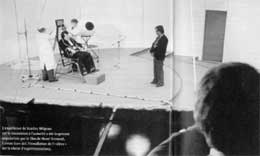![]() A thought-provoking experiment has demonstrated not only that cyberspace can be used to overcome ethical constraints in experiments but also how some of us are reluctant at the idea of torturing a virtual character.
A thought-provoking experiment has demonstrated not only that cyberspace can be used to overcome ethical constraints in experiments but also how some of us are reluctant at the idea of torturing a virtual character.
Stanley Milgram‘s 1960s experimental findings that people would administer apparently lethal electric shocks to a stranger at the behest of an authority figure remain critical for understanding obedience. Due to ethical reasons, it is nowadays impossible to carry out direct experimental studies in this area.
Mel Slater and his colleagues at University College London have used VR to reenact the Milgram’s experiment. Their objective was to uncover the extent to which participants would respond to the situation as if it were real in spite of their knowledge that no real events were taking place.
Participants were invited to administer memory tests to an avatar. When she gave an incorrect answer, the participants were instructed to administer an ‘electric shock’ to her, augmenting the voltage each time. She responded with increasing discomfort and protests. Of the 34 participants, 23 saw and heard the virtual human, and 11 communicated with her only through a text interface.
The participants who saw and heard her tended to respond to the situation at the subjective, behavioural and physiological levels as if it were real. Six of them chose to stop the experiment before it was due to end. A further 6 said it had occurred to them to stop early because they had negative feelings about what was happening. By contrast, of the eleven participants who only interacted with the (unseen) woman by text, just one stopped the experiment early, and no others said it had occurred to them to stop.
Participants who could see and hear the avatar were affected by the experiment as if it were real. Their stress responses were raised (as judged by sweating and heart rate). And when the woman protested, the participants tended to give her longer to answer before administering the shock. Some participants emphasised the correct answer among the available choices, as if trying to help the woman avoid a shock.
As Yishay Mor notes, the results put in a new light the idea that we should give human rights to sentient machines.
Image on the right from the movie I comme Icare
Videos related to Milgram experiment. Videos of the Virtual re-enactment of the obedience experiment.
Paper in PLoS ONE.
BoingBoing also points to another Milgram Reenactment, this time by Eric Paulos.



![7 art and tech ideas I discovered at Meta.Morf 2024 – [up]Loaded Bodies 7 art and tech ideas I discovered at Meta.Morf 2024 – [up]Loaded Bodies](https://we-make-money-not-art.com/wp-content/uploads/2024/05/53705969154_73dfdfea6f_c-300x200.jpeg)



